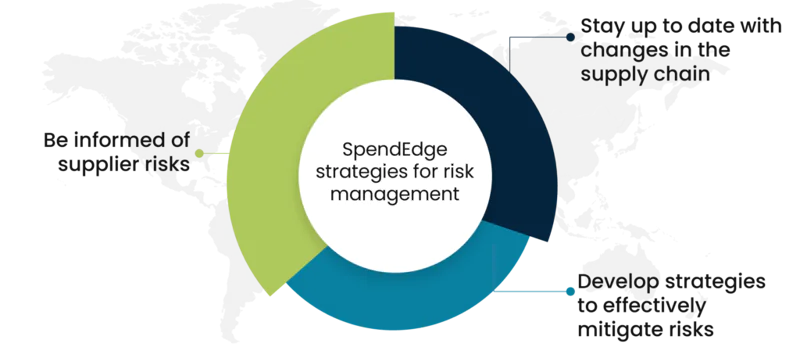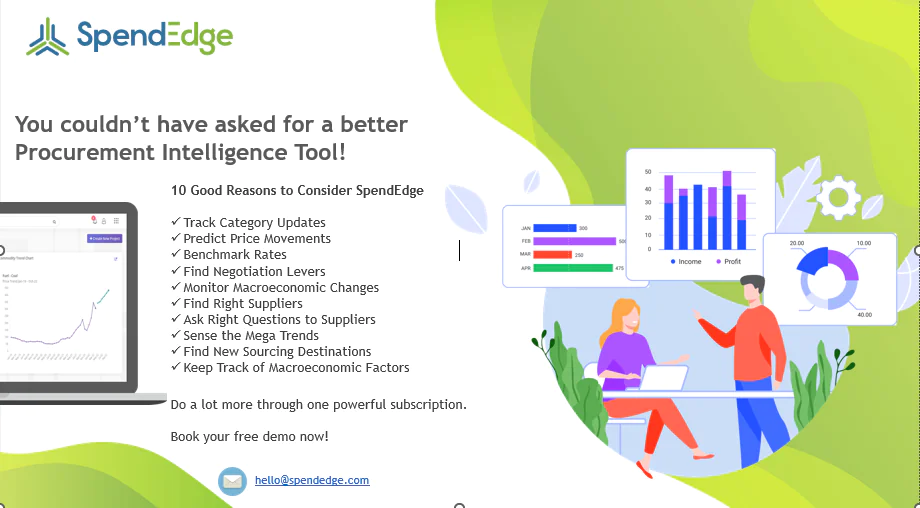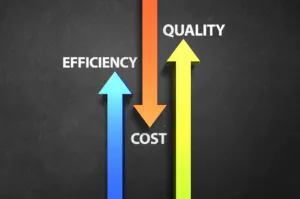By: George Mathew
Key Takeaways
- Identify and Manage Risks: Understanding and addressing both internal and external risks, such as operational, financial, and supplier risks, is essential for a resilient supply chain.
- Strategic Planning: Developing and implementing effective strategies, including contingency plans and supplier scorecards, helps mitigate potential disruptions.
- Continuous Monitoring: Regularly updating and monitoring the risk management framework ensures it remains effective in addressing new and evolving risks.
- Business Success and Competitive Advantage: A robust SCRM system is crucial for maintaining business success and gaining a competitive advantage in the marketplace.
What is supply chain risk management?
Risks related to a company’s supply chain are identified, evaluated, and prioritised as part of the systematic process known as supply chain risk management, or SCRM. It entails putting these risk-reduction plans into practice in order to maintain the business’s viability and profitability.
Several businesses are facing unexpected supply chain interruptions, resulting in expensive recalls costing hundreds of millions across various industries including automobile, pharmaceuticals, food and beverages, retail, and electronics. Moreover, both government entities and private enterprises are grappling with cybersecurity breaches, leading to loss of critical intellectual property due to deficiencies within the supplier network.
Supply chain risks can arise due to factors such as demand fluctuations, supplier issues, natural disasters, economic shifts, political instability, and regulatory challenges. Furthermore, new challenges such as cyber-attacks are emerging in addition to conventional and well recognized supplier vulnerabilities, such as supplier bankruptcy.
In contemporary multi-tier supply networks, the presence of numerous suppliers can create difficulties in pinpointing the entire group of suppliers, ranging from raw material origins to the assembly of the final system, which could require a significant amount of time to approach. Assessing the probability and consequences of different risks is difficult (e.g., forecasting weather or employee cybersecurity mistakes), which complicates their management, evaluation, and reduction. In intricate products, tier 1 or 2 suppliers might view their supply chains as confidential, thereby restricting visibility at the purchaser or integrated manufacturer level.
A risk management framework is necessary to identify, assess, and mitigate potential risks that could affect an organization’s objectives. It provides a structured approach to understanding and addressing risks, helping organizations make informed decisions, allocate resources effectively, and minimize the negative impact of unexpected events. This approach enhances organizations’ ability to navigate uncertainties and achieve their goals more successfully.
Risk management framework
Managing both known and unknown supply chain risks is a dynamic process that requires collaboration and adaptation to ensure a resilient supply chain. By addressing both risks, businesses can enhance their supply chain’s ability to handle disruptions and maintain continuity.
In case of known risks, companies should look to identify the risks, assess impact, use strategies such as contingency plans and diversification, and continually monitor and update mitigation efforts. In case of unknown risks, companies must plan for scenarios, prioritize flexibility, build strong relationships, embrace technology for visibility, and foster innovation to adapt to unforeseen disruptions effectively.
Risk identification and registration
Usually, risk identification involves recognizing and outlining potential risks that could affect the successful implementation of a process or project. This stage represents the initial step in risk management, aiming to systematically predict, evaluate, and manage potential threats to an organization. Risks are recorded properly and continuously monitored. At this stage, any part of the supply chain that lack data and require further examination should also be recorded.
Supply chain risk management
Each risk listed in the register needs to be evaluated using three criteria to establish a comprehensive risk management structure: the potential impact on the organization if the risk occurs, and the organization’s readiness to address that particular risk. The risk scores are subjected to tolerance thresholds that mirror the organization’s willingness to accept risk.
It is important to prioritize risks based on likelihood and impact, and develop contingency plans for each by regularly monitoring and updating the framework to adapt to changing circumstances. It is crucial to involve stakeholders and gather input throughout the process for a comprehensive approach.
Monitoring and updating
The risk management plan must undergo constant monitoring and updating as the project progresses. New risks could arise, and the probability and consequences of existing risks might change, underscoring the significance of maintaining an up-to-date risk management plan. This guarantees that the project remains covered from potential risks throughout its lifecycle.
Supply chain risk governance and review mechanism
Robust governance and review involve establishing structures and processes to oversee an organization’s activities. For supply chain risk management, it includes creating policies and procedures to assess and manage potential risks that could affect the supply chain. Regular reviews would involve periodic assessment of the supply chain to identify vulnerabilities, evaluate the effectiveness of risk mitigation strategies, and make necessary adjustments. This helps to ensure the resilience and efficiency of the supply chain.
Common risk factors that may occur during the process of risk management in supply chain
Internal Factors
To establish a robust Supply Chain Risk Management (SCRM) system, it’s essential to identify the internal risk factors inherent to a business’s supply chain. Key internal risk factors include:
Operational Risks: These involve the daily operations of a company. Examples include machinery breakdowns, IT system failures, or labor disputes, all of which can disrupt the supply chain.
Financial Risks: Factors such as changes in exchange rates, liquidity issues, or difficulties in accessing capital can impede a company’s ability to procure raw materials or pay suppliers promptly.
Strategic Risks: Business decisions like mergers, acquisitions, or market expansions can significantly impact the supply chain.
Human Resource Risks: Employee turnover, strikes, or inadequate training can affect the performance and efficiency of the supply chain.
Quality Risks: Compromises in product or raw material quality can lead to recalls, reputational damage, and financial losses within the supply chain.
External Factors
External factors significantly influence the performance of a supply chain. Beyond a company’s direct control, these factors require vigilant monitoring and dynamic risk mitigation strategies to ensure smooth operations. Key categories of external risks include:
Geopolitical Risks: Political instability, trade wars, tariffs, and changing regulations can dramatically impact supply chains, especially those spanning multiple countries.
Environmental Risks: Natural disasters such as earthquakes, hurricanes, or extreme weather events can severely disrupt manufacturing, transportation, and logistics.
Economic Risks: Economic downturns, fluctuating demand, and volatile commodity prices can present substantial challenges to the supply chain.
Technological Risks: Rapid technological advancements can make existing products or processes obsolete. Additionally, cyber-attacks or IT system failures can compromise the integrity of the supply chain.
Supplier Risks: Failures from suppliers, whether due to financial instability, operational issues, or other disruptions, can have cascading effects throughout the entire supply chain.
How SpendEdge can help with Supply Chain Risk Management Strategies:

Stay up to date with changes in the supply chain
Our procurement advisors play a crucial role in keeping organizations informed about supply chain updates and uncertainties. They monitor and assess potential disruptions in the supply chain, such as changes in transportation, regulatory issues, or geopolitical events, and provide guidance on how these factors could impact procurement strategies.
Develop strategies to effectively mitigate risks
Our experts help in identifying potential vulnerabilities and creating strategies to mitigate the risks affecting supply chain. This includes diversifying suppliers, creating contingency plans for disruptions, and establishing clear communication channels across the supply chain to ensure swift responses to unexpected events.
Our specialist advisors also help organizations in developing contingency plans and strategies to address unexpected events in business operations. These plans outline steps to be taken in case of various scenarios, such as supply chain interruptions, natural disasters, or economic downturns. Implementing these plans involve creating actionable steps, defining responsibilities, and ensuring that the organizations can quickly adapt to unforeseen circumstances.
Be informed of supplier risks
SpendEdge’s proprietory tool D-Risk helps to assess and manage supplier risks. Our procurement advisors utilize this tool to help organizations in evaluating and mitigating potential risks associated with their suppliers by analyzing internal and external risks, geopolitical factors, operational cost and stability, and reputation risks.
Our advisors are also capable of helping with the analysis of suppliers’ financial information, examining how they handle revenue and cash flows during periods of economic expansions and positive trends.
Success Story: How SpendEdge helped a CPG client
Our client is a mid-sized Consumer Packaged Goods (CPG) company based in France and has a worldwide presence. The company aims to provide sustainable products by anticipating emerging trends and addressing the ever-changing needs and preferences of consumers.
The client is encountering challenges with managing risks within their supply chain. These risks encompass a range of factors, including dealing with capacity limitations and addressing supply quality concerns, as well as solutions in order to strengthen their overall supply chain network.
Our procurement advisors assisted the client in overseeing the risk analysis procedure, assessing potential risks, and devising approaches to tackle these issues. Additionally, our research aided the client in incorporating past and current endeavors, which included business continuity and supply chain security efforts.

Contact us now to solve your procurement problems!
Conclusion
Effective Supply Chain Risk Management (SCRM) is crucial for ensuring business success and maintaining a competitive advantage. By identifying and addressing both internal and external risk factors through a systematic process, companies can mitigate operational, financial, strategic, quality, and supplier risks. Implementing robust strategies and utilizing tools like Supplier Scorecards can help organizations navigate shocks to supply and sustain resilient supply chain operations. Ultimately, a comprehensive approach to risk management enhances a company’s ability to achieve its objectives and thrive in a dynamic market environment.
Author’s Details
George Mathew
Associate Vice President, Sourcing and Procurement Intelligence
George is a procurement specialist at Infiniti Research and provides advisory services to clients across the pharmaceutical, CPG & FMCG, energy, and automotive sectors. He specializes in the procurement areas of industry benchmarking, cost modeling, rate card benchmarking, negotiation advisory, and supplier intelligence.




